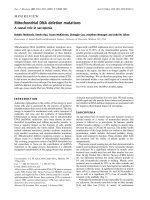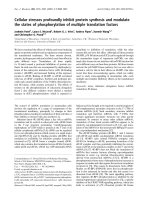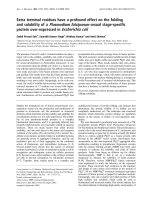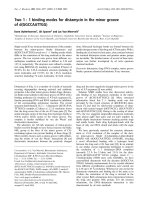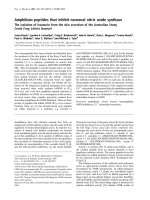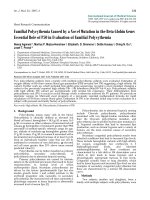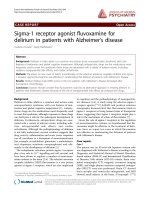Báo cáo y học: "Soluble IL-18 receptor complex: a new star in the firmament of rheumatoid arthritis diagnosis" pptx
Bạn đang xem bản rút gọn của tài liệu. Xem và tải ngay bản đầy đủ của tài liệu tại đây (132.64 KB, 3 trang )
Rheumatoid arthritis biomarkers
With the success of biologicals in the treatment of rheu-
matoid arthritis (RA), such as infl iximab, adalimumab
(anti-TNF), rituximab (anti-B-cell), and tocilizumab
(anti-IL-6), the armamentarium of physicians is expand-
ing so that personalized medicine is within our reach.
e study of Satoko Takei and colleagues [1] in this issue
of Arthritis Research & erapy describes a new serum
biomarker with clear potential of becoming a valuable
tool for the pharmaco diagnosis of RA. Biomarker tests
that are currently available are failing to guide therapeutic
decision making. C-reactive protein (CRP) and serum
amyloid protein are sensitive markers of disease activity
but blood levels often do not correlate with the obtained
therapeutic eff ect. e same holds true for IgM
rheumatoid factor and especially for anti-cyclic
citrullinated protein antibodies, although the latter are
specifi c for RA and of great prognostic value for the
outcome of disease [2]. It is important to monitor disease
activity during therapy in order to adjust, change or even
stop therapy when necessary. is is the reason that the
search for new biomarkers that can be used to monitor or
even predict therapeutic eff ectiveness is still ongoing.
Biomarkers identi ed by -omics
e major problem is that RA is a heterogeneous disease,
with disease course and extent of connective tissue
destruction varying considerably among patients. Histo-
logical evaluation of the infl amed synovium confi rms the
heterogeneity in RA, and cDNA microarray analysis of
synovial tissue showed that, for example, STAT1 (signal
tranducing and activator of transcription-1) gene
expression distinguishes between RA subtypes [3]. For
the diagnosis and management of disease, however, the
genetic analysis of the infl amed synovial tissue is
cumbersome. Blood is a highly dynamic environment,
communicating with practically every tissue in the body,
and is thus proposed as a ‘sentinel tissue’ that refl ects
disease progression in the body. Blood not only
transports soluble biomarkers but because the leukocytes
interact and communicate with practically every tissue,
they bear rich information regarding infl ammation and
immune responses. Whole genome expression profi ling
of blood cells from RA patients has identifi ed marker
genes the expression of which predicts with 86% accuracy
the response of infl iximab in RA [4]. More importantly,
only eight marker genes are needed to evaluate blood
cells for a valid prediction. Another study showed that
the expression of CD11c is a biomarker in monocytes to
identify responders to abdalumimab [5]. Interestingly,
the correlation of CD11c with response was lost when
methotrexate was co-administered, showing the narrow
window of CD11c as a predictive transcriptional bio-
marker. Many other genes are signifi cantly upregulated in
RA peripheral blood mononuclear cells compared to
healthy controls - for example, those encoding CD14
antigen, defensin-a1/3, and S100A proteins, which are of
potential diagnostic and prognostic value for RA. Over
the past decade, proteomics have yielded potential new
Abstract
It has long been recognized that laboratory tests
are useful in the diagnosis of disease and to monitor
treatment outcome. Their performance has become
even more demanding with the development of
personalized medicine. In patients with rheumatoid
arthritis (RA) the standard biochemical tests measure
serological markers of disease, such as C-reactive
protein, and RA-associated auto-antibodies, such
as rheumatoid factor and anti-citrullinated protein
antibodies. The information obtained from these
markers does not, however, provide a complete picture
of the disease and treatment e cacy. New biomarkers
based on cytokine receptor complexes are promising
for RA theragnostics.
© 2010 BioMed Central Ltd
Soluble IL-18 receptor complex: a new star in the
rmament of rheumatoid arthritis diagnosis?
Fons AJ van de Loo*
See related research by Takei et al., />EDITORIAL
*Correspondence:
Rheumatology Research & Advanced Therapeutics, Department of Rheumatology,
Radboud University Nijmegen Medical Centre, Geert Grooteplein 28, 6525 GA
Nijmegen, The Netherlands
van de Loo Arthritis Research & Therapy 2011, 13:111
/>© 2011 BioMed Central Ltd
candidates in the quest for better biomarkers for RA,
including the S100 proteins, serum amyloid A, alpha
1-antitrypsin, and apolipoproteins in the blood [6]. In
principle, carbohydrates, lipids and proteins (including
enzymes, matrix proteins or their neoepitopes,
autoantibodies, acute-phase proteins, chemokines,
growth factors, cytokines and their inhibitors, and
receptors) can be biomarkers for infl ammation,
connective tissue destruction, diagnosis and prognosis in
RA (reviewed by Carrasco and Barton [7]).
Soluble IL-18 receptor complex
Cytokines and cytokine-related molecules play a key role
in the pathogenesis of RA. Levels of TNFα, the soluble
TNF receptor-II, and IL-6 are elevated in serum but, due
to their short half-life and the complexity of the cytokine
network, it remains to be determined whether they can
be used as biomarkers in a clinical setting. IL-18 is a
member of the IL-1 cytokine superfamily and plays a key
role in the regulation of immunity and infl ammation [8].
Its biological eff ect is regulated at diff erent levels. IL-18 is
synthesized as a larger precursor protein that requires
caspase-1-mediated cleavage for activation. For IL-18 cell
signaling, IL-18 binds to the IL-18 receptor (IL-18R)α
with relatively low affi nity and attracts the signal trans-
ducing IL-18Rβ chain (also termed the IL-1R accessory
protein-like chain) to form a functional receptor
complex. In vivo, its biological activity is also dependent
on secreted IL-18 binding proteins and the soluble forms
of both its receptors: IL-18Rα probably by enzymatic
cleavage and IL-18Rβ as an alternative splicing event.
eir regulatory properties might be diff erent as IL-18
binding protein ameliorates collagen-induced arthritis
whereas soluble IL-18Rβ aggravates it [9,10]. Previously,
Bresnihan and colleagues [11] demonstrated raised serum
levels of IL-18 and its binding protein in RA patients
compared to psoriatic arthritis patients, but this did not
seem to correlate with response to therapy with metho-
trexate, whereas CRP levels did. Interestingly, IL-18
protein expression in synovial tissue did correlate with
serum CRP and disease activity in infl ammatory arthritis
[12], indicating a local role in the pathophysiology of
disease. A comparative study of diff erent biomarkers,
either circulating or expressed in the synovial tissue,
showed the utility of serum tissue inhibitor of metallo-
proteinases (TIMP) as predictive for a later therapeutic
response to anakinra [13]. is study confi rmed previous
fi ndings that serum IL-18 correlates poorly with disease
activity and treatment response but is highly predictive
for radiographic progression of the disease [13]. e
study of Takei and colleagues [1] demonstrates that the
systemic soluble IL-18Rα complex, which in vitro exhibits
antagonistic activity, probably also contains a dimeric
IL-18 protein and the soluble form of the IL-18Rβ chain.
e serum levels of this complex were signifi cantly higher
in patients with RA and adult-onset Still’s disease than in
healthy controls and osteoarthritis and systemic lupus
erythematosus patients. Moreover, treatment of RA
patients with the TNF inhibitor etanercept resulted in a
signifi cant improvement in serum levels of soluble IL-
18Rα complex. It remains to be seen whether the soluble
IL-18Rα complex can be used for the evaluation of joint
damage or disease activity but even so it could be useful
for the diagnosis of RA e soluble IL-18Rα complex as a
biomarker may capture the com plexity of the
infl ammatory process: the shedding of membrane
IL-18Rα as a marker of enhanced proteolytic activity; the
activation and release of IL-18 by the infl ammasome as a
marker of innate immunity; and the alternatively spliced
soluble IL-18Rβ, which is mainly expressed in the
lymphoid organs and regulates IL-18-driven T-cell
immunity [10]. Currently, CRP is still a useful and reliable
marker for disease activity and treatment response in the
clinic. However, it is recog nized that combinations of
biomarkers will greatly enhance the power for diagnosis
and the soluble IL-18Rα complex may be useful in this
regard for RA, but longitudinal studies and cross-
sectional analysis are warranted.
Abbreviations
CRP, C-reactive protein; IL, interleukin; IL-18R, interleukin-18 receptor; RA,
rheumatoid arthritis; TNF, tumor necrosis factor.
Competing interests
The author declares that he has no competing interests.
Published: 27 April 2011
References
1. Takei S, Hoshino T, Matsunaga K, Sakazaki Y, Sawada M, Oda H, Takenaka S-I,
Imaoka H, Kinoshita T, Honda S, Ida S, Fukuda T-A, Aizawa H: Soluble
interleukin-18 receptor complex is a novel biomarker in rheumatoid
arthritis. Arthritis Res Ther 2011, 13:R52.
2. Van Venrooij WJ, van Beers JJ, Pruijn GJ: Anti-CCP antibody, a marker for the
early detection of RA. Ann N Y Acad Sci 2008, 1143:268-285
3. Van der Pouw Kraan TC, an Gaalen FA, Kasperkovitz PV, Verbeet NL, Smeets TJ,
Kraan MC, Fero M, Tak PP, Huizinga TW, Pieterman E, Breedveld FC, Alizadeh
AA, Verweij CL: RA is a heterogeneous disease: evidence for di erences in
the activation of the STAT-1 pathway between rheumatoid tissues. Arthritis
Rheum 2003, 48:2132-2145.
4. Julià A, Erra A, an Gaalen FA, Kasperkovitz PV, Verbeet NL, Smeets TJ, Kraan
MC, Fero M, Tak PP, Huizinga TW, Pieterman E, Breedveld FC, Alizadeh AA,
Verweij CL: An eight-gene blood expression pro le predicts the response
to in iximab in RA. PLoS One 2009, 4:e7556.
5. Stuhlmüller B, Häupl T, Hernandez MM, Grützkau A, Kuban RJ, Tandon N, Voss
JW, Salfeld J, Kinne RW, Burmester GR: CD11c as a transcriptional biomarker
to predict response to anti-TNF monotherapy with adalimumab in
patients with RA. Clin Pharmacol Ther 2010, 87:311-321.
6. Vanarsa K, Mohan C: Proteomics in rheumatology: the dawn of a new era.
F1000 Med Rep 2010, 2:87.
7. Carrasco R, Barton A: Biomarkers of outcome in rheumatoid arthritis.
Rheumatology Reports 2010, 2:26-38.
8. Dinarello CA: Interleukin-18 and the treatment of rheumatoid arthritis.
Rheum Dis Clin North Am 2004, 30:417-434.
9. Plater-Zyberk C, Joosten LA, Helsen MM, Sattonnet-Roche P, Siegfried C,
Alouani S, van de Loo FA, Graber P, Aloni S, Cirillo R, Lubberts E, Dinarello CA,
van Den Berg WB, Chvatchko Y: Therapeutic e ect of neutralizing
van de Loo Arthritis Research & Therapy 2011, 13:111
/>Page 2 of 3
endogenous IL-18 activity in the collagen-induced model of arthritis. J Clin
Invest 2001, 108:1825-1832.
10. Veenbergen S, Smeets RL, Bennink MB, Arntz OJ, Joosten LA, van den Berg
WB, van de Loo FA: The natural soluble form of IL-18 receptor beta
exacerbates collagen-induced arthritis via modulation of T-cell immune
responses. Ann Rheum Dis 2010, 69:276-283.
11. Bresnihan B, Roux-lombard P, Murphy E, Kane D, FitzGerald O, Dayer J-M:
Serum interleukin 18 and interleukin 18 binding protein in rheumatoid
arthritis. Ann Rheum Dis 2002, 62:726-729.
12. Rooney T, Murphy E, Benito M, Rou-Lombard P, FitxGerald O, Dayer J-M,
Bresnihan B: Synovial tissue interleukin-18 expression and the response to
treatment in patients with in ammatory arthritis. Ann Rheum Dis 2004,
63:1393-1398.
13. Rooney T, Roux-Lombard O, Veale DJ, FitzGerald O, Dayer J-M, Bresnihan B:
Synovial tissue and serum biomarkers of disease activity, therapeutic
response and radiographic progression: analysis of a proof-of-concept
randomized clinical trial of cytokine blockade. Ann Rheum Dis 2010,
69:706-714.
doi:10.1186/ar3308
Cite this article as: van de Loo FAJ: Soluble IL-18 receptor complex: a new
star in the rmament of rheumatoid arthritis diagnosis? Arthritis Research &
Therapy 2011, 13:111.
van de Loo Arthritis Research & Therapy 2011, 13:111
/>Page 3 of 3


